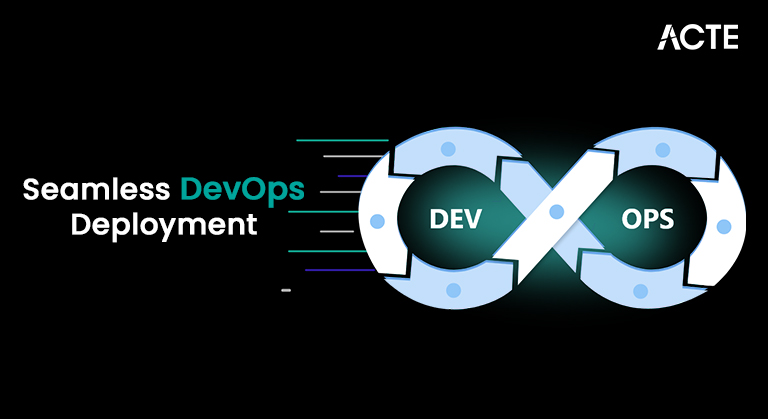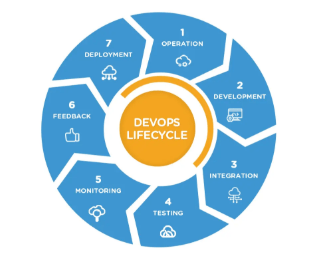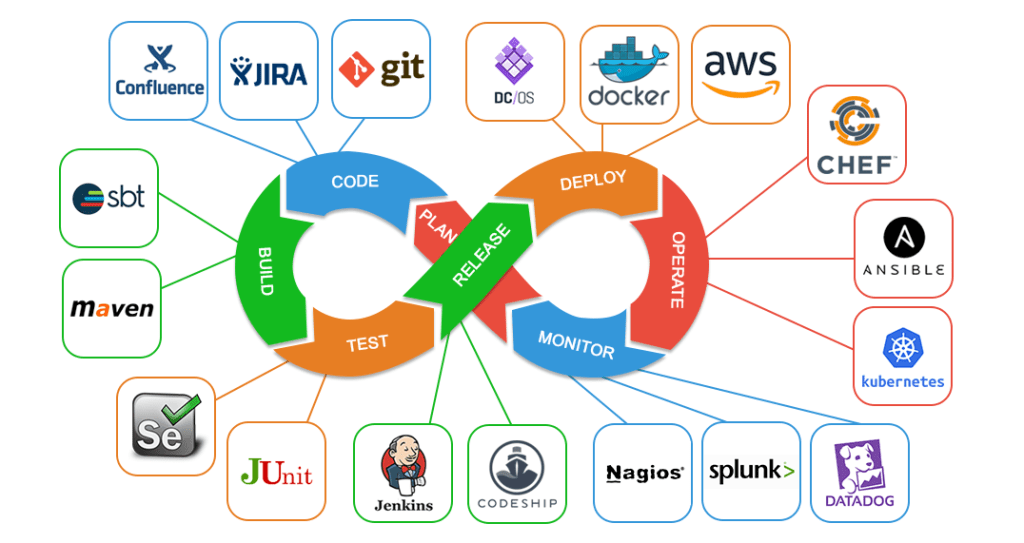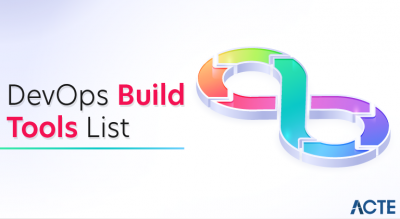
- Introduction to DevOps
- Importance of DevOps in Software Development
- DevOps Lifecycle: Key Phases
- Role of Automation in DevOps Deployment
- CI/CD in DevOps: Enhancing Deployment Speed
- DevOps Deployment Strategies (Blue-Green, Canary, Rolling)
- Popular DevOps Tools for Deployment (Docker, Kubernetes, Ansible)
- Benefits of DevOps for Software Deployment
- Security Considerations in DevOps Deployment
- Challenges in Implementing DevOps Deployment
- Case Studies of DevOps Success Stories
- Conclusion
Introduction to DevOps
DevOps, a combination of the terms “development” and “operations,” refers to a set of practices, principles, and cultural philosophies aimed at improving collaboration between development (Dev) and operations (Ops) teams. DevOps aims to streamline and automate the processes of software development, testing, deployment, and monitoring to achieve faster, more reliable, and continuous delivery of software applications. Traditionally, software development and IT operations were separate functions within an organization. Development teams were responsible for writing and testing code, while operations teams managed the infrastructure, deployment, and maintenance. DevOps Training separation often resulted in miscommunication, slow release cycles, and an inability to quickly respond to user feedback or change business requirements. DevOps aims to bridge this gap by fostering better communication, collaboration, and automation across teams, resulting in improved software quality and faster delivery cycles.
Importance of DevOps in Software Development
The importance of DevOps in modern software development cannot be overstated. With businesses increasingly relying on software to drive innovation, increase operational efficiency, and enhance customer experiences, the ability to release software quickly and reliably has become crucial for staying competitive. DevOps offers several key benefits that directly impact the success of software development:
- Faster Time to Market: DevOps enables teams to release software updates, new features, and bug fixes more frequently and efficiently, reducing time to market.
- Improved Collaboration and Communication: By breaking down silos between development and operations teams, DevOps fosters collaboration, better communication, and a shared sense of ownership.
- Increased Automation: DevOps emphasizes automation across the software lifecycle, from code integration to testing, deployment, and monitoring. This reduces manual intervention and human error, resulting in more consistent and reliable deployments.
- Continuous Delivery: DevOps facilitates continuous integration and continuous delivery (CI/CD), allowing organizations to Devops Tools for Database Management code in more minor, incremental releases that can be tested and monitored in real-time.
- Enhanced Software Quality: With automated testing and faster feedback loops, DevOps helps detect defects early, improving the overall software quality.
- Scalability and Flexibility: DevOps practices, mainly through containerization and cloud technologies, enable applications to be deployed and scaled quickly, ensuring they can adapt to changing business needs and traffic patterns.
Start your journey in Devops by enrolling in this Devops Online Course.
DevOps Lifecycle: Key Phases
The DevOps lifecycle consists of several stages, each focusing on automating and improving different software development and delivery aspects. The key phases of the DevOps lifecycle are:
- Plan: The planning phase involves gathering requirements, setting goals, and defining the roadmap for software development. Teams use collaboration tools to ensure alignment between development and operations on the project scope and timelines.
- Develop: During the development phase, developers write and commit code. Version control systems, such as Git, track changes and ensure proper code management.
- Build: The build phase involves compiling and packaging the code into executable files, libraries, or containers. Automated build systems, such as Jenkins, are often used to ensure that builds are consistent and reproducible.
- Test: Testing is an essential part of the DevOps lifecycle. Automated testing are executed to ensure that the code meets quality standards. These tests include unit, integration, functional, and performance tests.
- Release: The release phase is when the code is deployed to production or staging environments. Top Most Devops Security Tools , this process is automated to reduce human errors and improve deployment frequency.
- Deploy: This phase involves deploying applications to production environments. With DevOps, deployment is automated testing and often follows a continuous delivery approach, meaning that software can be deployed frequently and reliably.
- Operate: After deployment, the application is monitored in the production environment. Monitoring tools such as Prometheus and Grafana track application performance, detect errors and ensure the software runs smoothly.
- Monitor: The monitoring phase is critical for maintaining high availability and performance. Operations teams continuously track system health, security vulnerabilities, and performance metrics to ensure the application operates as expected.

Role of Automation in DevOps Deployment
Automation is the cornerstone of DevOps and plays a central role in streamlining the development and deployment processes. By automating repetitive tasks, teams can achieve faster, more reliable software delivery and minimize human errors. Here are some key areas where automation enhances DevOps deployment:
- Continuous Integration (CI): CI involves automatically building, testing, and integrating code changes as soon as they are committed. This ensures that code is always in a deployable state and that potential issues are detected early in the development cycle.
- Continuous Delivery (CD) : It automates the deployment process, allowing code to be released to production with minimal manual intervention. This ensures that deployments are fast, consistent, and repeatable, reducing the risk of errors during the process.
- Automated Testing: Automating unit tests, DevOps Training , and performance tests allows for faster and more reliable feedback, ensuring that only quality code is deployed to production.
- Infrastructure as Code (IaC): IaC allows teams to define and manage infrastructure using code, making the provisioning of servers, networking, and other resources repeatable and consistent. Tools like Terraform and Ansible are commonly used to automate infrastructure provisioning.
- Deployment Automation: Deployment automation tools, such as Jenkins, GitLab CI/CD, and Azure DevOps, automate deploying applications to various environments (e.g., staging, production). This reduces the risk of deployment errors and allows teams to release updates quickly.
- Blue-Green Deployment: Blue-green deployment involves maintaining two separate environments one for production (blue) and one for staging (green). New releases are deployed to the green environment, and once validated, traffic is switched from the blue environment to the green environment. This strategy minimizes downtime and allows for easy rollbacks if issues arise.
- Canary Deployment: In a canary deployment, a new application Ansible in Devops is released to a small subset of users or servers (the “canary” group). This allows teams to monitor the latest release in a live environment, and if issues are detected, the deployment can be stopped or rolled back before it affects all users.
- Rolling Deployment: A rolling deployment gradually replaces instances of the previous version with the new version step-by-step. This approach ensures that some instances of the application are always running, minimizing downtime. If problems arise, the deployment can be halted at any stage.
- Docker: Docker is a platform that enables developers to package applications and their dependencies into containers. These containers can be easily deployed across different environments, ensuring the application runs consistently. Docker simplifies the deployment of microservices and enables developers to use the same environment across development, staging, and production.
- Kubernetes: Kubernetes is an open-source container orchestration platform that automates containerized applications’ deployment, scaling, and management. It simplifies the management of microservices by handling container distribution, load balancing, and service discovery. Kubernetes is widely used with Docker to manage complex application deployments at scale.
- Ansible: Ansible is a configuration management and automation tool that helps automate application provisioning, configuration, and deployment. It allows teams to define infrastructure as code, ensuring consistency and repeatability. Ansible can be used to automate tasks such as server setup, application deployment, and configuration management.
- Faster Time to Market:: DevOps practices, especially CI/CD, enable teams to release software faster and more frequently, improving time to market.
- Improved Quality and Stability: Continuous testing, integration, and monitoring in DevOps ensure that only stable and high-quality code is deployed to production.
- Greater Flexibility and Scalability: Devops Career Path practices like containerization and infrastructure automation allow applications to scale quickly and adjust to changing business requirements.
- Reduced Downtime: Deployment strategies like blue-green and canary deployments minimize downtime, ensuring users experience minimal disruption.
- Better Collaboration: DevOps fosters collaboration between development, operations, and other stakeholders, improving the overall software delivery process.
- Amazon: Amazon Web Services (AWS) uses DevOps practices to deploy new features and updates to its cloud infrastructure quickly and reliably.
- Netflix: Netflix uses a combination of microservices, containers, and CI/CD pipelines to deliver millions of hours of streaming content daily with high reliability.
- Spotify: It utilizes DevOps to continuously release new features and ensure its platform can handle millions of users without interruption.
Gain in-depth knowledge of Devops by joining this Devops Online Course now.
CI/CD in DevOps: Enhancing Deployment Speed
Continuous Integration (CI) and Continuous Delivery (CD) are two of the most important practices in the DevOps process. They significantly enhance deployment speed and reduce lead times. CI and CD ensure that developers can push code more quickly, efficiently, and safely. This results in faster delivery of new features, bug fixes, and improvements to users, giving businesses a competitive edge.
Continuous Integration (CI) ensures that developers integrate their code changes into a shared repository frequently, often multiple times per day. What Is Devops practice allows teams to detect integration issues and fix them promptly, preventing the accumulation of bugs and ensuring that the code is always deployable.
Continuous Delivery (CD) extends CI by automating the deployment pipeline. Once code passes automated testing and quality checks, it can be automatically deployed to staging environments or production. CD enables teams to deploy changes to production as soon as they are validated, reducing lead times and increasing deployment frequency.
DevOps Deployment Strategies (Blue-Green, Canary, Rolling)
Several deployment strategies are commonly used in DevOps to ensure that software is deployed with minimal risk and downtime. These strategies help manage how updates are released to production environments.
Aspiring to lead in Devops? Enroll in ACTE’s Devops Masters Course and start your path to success!
Popular DevOps Tools for Deployment (Docker, Kubernetes, Ansible)
Several powerful tools assist with the deployment process in DevOps:

Benefits of DevOps for Software Deployment
DevOps brings a wide array of benefits to software deployment, making it an essential practice for organizations aiming to improve their software delivery process:
Preparing for Devops interviews? Visit our blog for the best Devops Interview Questions & Answer
Security Considerations in DevOps Deployment
Security is a critical aspect of any DevOps deployment. DevSecOps is the practice of integrating security into the DevOps pipeline, ensuring that security vulnerabilities are identified and addressed early in the development process. Some key security considerations in DevOps deployment include, Automated Security Testing Integrating automated security testing into the CI/CD pipeline helps detect vulnerabilities early in the development cycle. Secure Code Practices Developers should follow secure coding practices to prevent common vulnerabilities, such as SQL injection and cross-site scripting (XSS). Access Control Ensure only authorized individuals can access sensitive code and production environments. Monitoring and Logging Continuous monitoring of production environments helps identify security incidents and vulnerabilities in real-time.
Challenges in Implementing DevOps Deployment
While DevOps offers many benefits, implementing it successfully can be challenging. Common challenges include, Cultural Resistance Shifting to a DevOps culture requires significant changes in organizational mindset and practices, which can be met with resistance from teams used to working in silos. Tooling Complexity Setting up and managing the various tools required for DevOps, such as CI/CD pipelines, monitoring systems, and configuration management tools, can be daunting. Security Risks Ensuring the security of the Azure Devops Certification and production environment is critical, and vulnerabilities can be introduced without proper attention. Integrating legacy systems into a modern DevOps pipeline can be difficult and time-consuming.
Case Studies of DevOps Success Stories
Several organizations have successfully implemented DevOps practices, yielding significant improvements in software delivery. For example:
Conclusion
DevOps has revolutionized the way software is developed, deployed, and maintained. By fostering collaboration, automating processes, and integrating continuous testing and delivery, DevOps allows organizations to release software faster, more reliably, and with better quality. Looking ahead, we expect DevOps Training practices to evolve with AI, machine learning, and automation advancements. DevOps will remain a critical driver of software delivery and innovation as businesses increasingly adopt cloud-native technologies and microservices architectures. The future of DevOps promises even greater efficiency, security, and scalability, making it an essential practice for organizations aiming to stay competitive in a fast-paced digital landscape.





